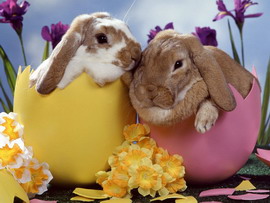Easter is coming early this year. Unlike Christmas, where kids scramble to be Good in the lead up to 25 December, Easter sometimes sneaks up on us, due in part to its rotating calendar date. Santa Claus has it all pegged out – he has his high tech, computerized Naughty and Nice list churning out statistics on a daily basis, slotting kids world-wide into categories that ultimately determine their ranking on the Big Gift/Small Gift/Lump of Coal scale.
The Easter Bunny isn’t that sophisticated.
I don’t know much about the elusive Monsieur Rabbit, but I imagine he is a simple fellow. I imagine he lives in a sunny dale somewhere near the Lake District in England, under a gentle hill bedecked with lime green grass and pink daisies. I imagine he wakes each morning, pops on his denim overalls (with a hole for his fluffy white tail), perches bifocals on his twitching nose and sets his small army of worker bunnies to smelting great slabs of chocolate before pouring it into a myriad of moulds located in an underground warren of Pascal delight.
He probably out-sources the colored foil wrapping, then stores the freshly wrapped eggs in a cool den somewhere in the labyrinth of his underground empire. Afterwards, he more than likely has a cup of tea and a piece of carrot cake, then hops off over the dales for an afternoon lollop in the sunshine.
Come Easter Sunday, Mr. Rabbit would put on his jet-powered, super-sonic, land-bounding hopping shoes, sling his never-ending choc-egg supply onto his back, screw his peak cap (emblazoned with the word “eggscellent”) down over his ears, fire up his shoes, and bound into the first leg of his lengthy world-wide, egg-delivering route.
You see, Easter-egg-hungry kids are everywhere nowadays. Even Beijing.
The origins of the Easter Bunny are mixed. Some people believe he was created after the pet rabbit of the Germanic goddess Eostre – a rabbit who laid colored eggs. Other people believe the Bunny’s origin comes from Pagan times when rabbits represented fertility and new life. Of course, in Christianity, Jesus is New Life personified.
Easter traditions around the world also vary. In Bulgaria, people take turns tapping eggs against other eggs; the person who’s egg breaks last will have a year of good luck. In Germany, people blow out eggs, paint them with beautiful designs and hang them on tree branches, sort of like a Christmas tree (then they feast on omelettes for days). In Poland, Easter Monday is known as “Switching Day” – a day when boys whisk girls with small willow branches (girls, don’t let your brother read this). In England on Good Friday, people devour fragrant hot cross buns, warmed and smeared with butter. They also eat Simnel cakes, covered in home-made marzipan. In Greece, children are given special candles and the whole family eats a sweet plaited bread called tsoureki, studded with bright red eggs.
Whatever you do this Easter, don’t forget to take a moment to remember the blessings of new life and new beginnings. As Beijing lopes into spring, we can all appreciate and celebrate this wonderful time of year.
Fu huo jie kuai le!
Footnote: the Easter Bunny isn’t so unsophisticated that he doesn’t have a computer. This is his email address if you want to drop him a line some time… eggs@easterbunnys.net.
Kids – check out Kaboose.com (holidays.kaboose.com/spring/easter.html) or The Bunny Hutch (www.kidsturncentral.com/holidays/easter.htm) for Easter games, recipes, crafts and activities.
Mum and Dad – check out some links at Family and Kids Easter (www.rexanne.com/easter-kids.html).




